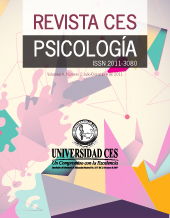The construction of oral productions in childhood from realistic and unrealistic images
DOI:
https://doi.org/10.21615/cesp.13.2.6Keywords:
Narratives, Descriptions, Unrealistic Pictures, Realistic Picture, Children, Cognitive Development, Language, LearningAbstract
The aim of this paper was to examine the creation of fictional narratives by 5 and 6 year-old children from images with different levels of realism. We analyzed 49 stories, 24 from realistic images and 25 from unrealistic images. First, the productions were classified into narratives, descriptions and other productions, and analyzed the arrangement of the images. Most of the children who participated in the unrealistic condition created narratives and identified one image for the beginning and another for the ending; while those who observed realistic images mostly made descriptions and did not arrange them into sequences. It was analyzed: number of words and segments and number of kinds of words; glossaries and segments of words sorted by frequency; characteristic responses (the most significant of each group). No differences were found neither in the number of words nor in the number of different word types used in each production. However, differences were found in the characteristic words and in the complete responses that characterized each group. More nouns were used in the descriptions, while verbs and causal connectors were used in the narratives. The characteristic response of the description consisted in a presentation of the images separately. The narrative introduced a conflict or emotional state, a resolution and a closure. The results showed that the children developed different productions (narrations or descriptions) according to the type of images they were exposed.
Downloads
References
Alam, F. (2015). La construcción interaccional de narrativas de ficción entre niños de distintas edades. Un estudio con niños de poblaciones urbano marginadas. Interdisciplinaria, 32(1), 31-49. Recuperado de: http://www.redalyc.org/articulo.oa?id=18041090002
Alam, F., & Rosemberg, C.R. (2016). ¡Uy, no! ¡Mirá lo que pasó!? Uso de recursos evaluativos en narrativas de ficción por niños pequeños de poblaciones urbano-marginadas. Íkala, 21, 281-297. doi: http://dx.doi.org/10.17533/udea.ikala.v21n03a03
Alarcon-Neve, L. J., & Auza-Benavides, A. (2015). Uso y función de nexos en la subordinación y coordinación. Evidencia de dos tareas narrativas de niños mexicanos de primero de primaria. En E.P. Velázquez Patiño & I. Rodriguez Sánchez (Eds.). Estudios de lingüística funcional (pp. 223-251). México: Editorial Universitaria UAQ (Col. Academia, Serie Nodos).
Aluja, T., & Morineau, A. (1999). Aprender de los datos: el análisis de componentes principales. Una aproximación desde el Data Mining. Barcelona: Ediciones Universitarias de Barcelona.
Beaudouin, V. (2016). Retour aux origines de la statistique textuelle: Benzécri et l’école française d’analyse des données. Statistical Analysis of Textual Data - JADT 2016, 17–27.
Berman, R. A., & Katzenberger, I. (2004). Form and function in introducing narrative and expository texts: A developmental perspective. Discourse Processes, 38, 57–94. doi: http://dx.doi.org/10.1207/s15326950dp3801_3
Bornens, M. (1990). Problems brought about by “reading” a sequence of pictures. Journal of Experimental Psychology, 49, 189–226. doi: http://dx.doi.org/10.1016/0022-0965(90)90055-D
Brown, A. L. (1975). Recognition, reconstruction and recall of narrative sequences by preoperational children. Child Development, 46, 156-166. doi: http://dx.doi.org/10.2307/1128844
Brown, A. L., & French, L. A. (1976). Construction and regeneration of logical sequences using causes or consequences as point of departure. Child Development, 41, 930-940. doi: http://dx.doi.org/10.2307/1128428
Bruner, J. (1986). El habla del niño. Barcelona: Paidós.
Bruner, J. (2013). La fábrica de historias. Derecho, literatura, vida. Buenos Aires: Fondo de Cultura Económica.
Carmiol, A. M., & Sparks, A. (2014). Narrative development across cultural contexts: Finding the pragmatic in parent – child reminiscing. En D. Mathews (Ed). Pragmatic Development in First Language Acquisition (pp. 279-293). Amsterdam: John Benjamins.
DeLoache, J. S. (2004). Becoming symbol-minded. Trends in Cognitive Sciences, 8, 66-70. doi: http://dx.doi.org/10.1016/j.tics.2003.12.004
DeLoache, J. S., & Burns, N. (1994). Early understanding of the representational function of pictures. Cognition, 52, 83-110. doi: http://dx.doi.org/10.1016/0010-0277(94)90063-9
DeLoache, J. S., & Marzolf, D. (1992). When a picture is not worth a thousand words: Young children’s understanding of pictures and models. Cognitive Development, 7, 317-329. doi: http://dx.doi.org/10.1016/0885-2014(92)90019-N
DeLoache, J. S., Peralta, O.A., & Anderson, K. N. (1999). Multiple factors in early symbol use: Instructions, similarity, and age in understanding a symbol-referent relation. Cognitive Development, 14, 299–312. doi: http://dx.doi.org/10.1016/s0885-2014(99)00006
DeLoache, J. S., Pierroutsakos, S., & Troseth, G. (1996). The three R’s of pictorial competence. En R. Vasta (Ed.), Annals of child development (Vol. 12, pp. 1-48).
Fivush, R., Haden, C. A., & Reese, E. (2006). Elaborating on elaborations: The role of maternal reminiscing style in cognitive and socioemotional development. Child Development, 77, 1568-1588. doi: http://dx.doi.org/10.1007/s10615-0 06-0065-1
Ganea, P. A., Allen, M., Butler, L., Carey, S. & DeLoache, J. S. (2009). Toddlers’ referential understanding of pictures. Journal of Experimental Child Psychology, 104, 283-295. doi: http://dx.doi.org/10.1016/j.jecp.2009.05.008
Ganea, P. A., Bloom-Pickard, M., & DeLoache, J. S. (2008). Transfer between picture books and the real world by very young children. Journal of Cognition and Development, 9, 46-66. doi: http://dx.doi.org/10.1080/15248370701836592
Glaser, B., & A. Strauss (1967). The discovery of grounded theory. Chicago: Aldine Publishing Company.
Harris, P. (2005). El funcionamiento de la imaginación. Buenos Aires: Fondo de Cultura Económica.
Hess, K., & Prado, M.L. (2013). ¿Te leo un cuento? La lectura de relatos en el desarrollo narrativo de niños en edad preescolar. En A. Auza & K. Hess (Eds.) ¿Qué me cuentas? Narraciones y desarrollo lingüístico en niños hispanohablantes (pp. 111-140). México: DeLaurel-UAQ-Hospital General Manuel Gea González.
Karmiloff-Smith, A. (1985). Language and cognitive processes from a developmental perspective. Language and Cognitive Processes, 1, 61–85. doi: http://dx.doi.org/10.1080/01690968508402071
Mareovich, F., & Peralta, O.A. (2015). La Comprensión Referencial Temprana: Aprendiendo Palabras a Través de Imágenes con Distinto Nivel de Iconicismo. Psykhe, 24, 1–11. doi: http://dx.doi.org/10.7764/psykhe.24.1.661
Mareovich, F., & Peralta, O.A. (2016). Learning an adjective. The impact of descriptive information / Aprendiendo un adjetivo. El impacto de la información descriptiva. Infancia y Aprendizaje, 39(3), 528-559. doi: http://dx.doi.org/10.1080/02103702.2016.1189120
Mareovich, F., Taverna, A., & Peralta, O. A. (2015). Enseñando palabras mediante libros ilustrados: El aprendizaje temprano de sustantivos y adjetivos. Interdisciplinaria, 32, 89–107. doi: http://dx.doi.org/10.16888/interd.2015.32.1.5
McCabe, A., & Peterson, C. (1991). Developing narrative structure. Hillsdale, NJ: Erlbaum.
Moscoloni, N. (2005). Las nubes de datos. Métodos para analizar la complejidad. Rosario: UNR Editora.
Nelson, K. (1996). Language in cognitive development. Cambridge: Cambridge University Press.
Ninio, A., & Bruner, J. (1978). The achievement and antecedents of labeling. Journal of Child Language, 5, 1-15. doi: https://doi.org/10.1017/S0305000900001896
Paris, A. H., & Paris, S. G. (2003). Assessing narrative comprehension in young children. Reading Research Quarterly, 38, 36 –76.doi: http://dx.doi.org/10.1598/RRQ.38.1.3
Peralta, N., Castellaro, M., & Santibáñez, C. (2020). El análisis de datos textuales como metodología para el abordaje de la argumentación: una investigación con estudiantes de pregrado en universidades chilenas. Íkala, Revista de Lenguaje y Cultura, 25(1), 209-227. http://doi.org/10.17533/udea.ikala.v25n01a02
Peterson, C., & McCabe, A. (1983). Developmental Psycholinguistics: Three Ways of Looking at a Child’s Narrative. New York: Plenum Press.
Peterson, C., & McCabe, A. (1994). A social interactionist account of developing decontextualized narrative skill. Developmental Psychology, 30, 937 – 948. doi: http://dx.doi.org/10.1037/0012-1649.30.6.937
Piaget. J. (1946). Le développement de la notion du temps chez L’enfant. Paris: Presses Universitaires de France.
Pressley, M., Almasi, J., Schuder, T., Bergman, J., Hite, S., El-Dinary, P. B., & Brown, R. (1994). Transactional instruction of comprehension strategies: The Montgomery County, Maryland, SAIL program. Reading and Writing Quarterly, 10, 5–19. doi: http://dx.doi.org/10.1080/1057356940100102
Schmidt, C. R., Paris, S. G., & Stober, S. (1979). Inferential distance and children's memory for pictorial sequences. Developmental Psychology, 15(4), 395-405. doi: https://doi.org/10.1037/0012-1649.15.4.395
Schmidt, C. R., & Paris, S. G. (1978). Operativity and reversibility in children’s understanding of pictorial sequences. Child Development, 49, 1219–1222. doi: https://doi.org/10.2307/1128764
Shapiro, L. R., & Hudson, J. A. (1991). Tell me a make-believe story: coherence and cohesion in young children’s picture-elicited narratives. Development Psychology, 27, 960–74. doi: https://doi.org/10.1037/0012-1649.27.6.960
Sigel, I. E. (1978). The development of pictorial comprehension. En B. Randhawa& W. Coffman (Eds.) Visual learning, thinking and communication, (pp. 93-111). Nueva York: Academic Press.
Sigel, I. E. (1997). Modelo de distanciamiento y desarrollo de la competencia representativa. Infancia y Aprendizaje, 78, 13-29. doi: https://doi.org/10.1174/021037097761403118
Snow, C. E., & Goldfield, B. (1983). Turn the page please: Situation specific language acquisition. Journal of Child Language, 10, 551-570. doi: https://doi.org/10.1017/S0305000900005365
Snow, C. E., & Ninio, A. (1986). The contracts of literacy: What children learn from learning to read books. En W.H. Teale & E. Sulzby (Eds.), Emergent literacy: Writing and reading (pp. 116–138). Norwood, NJ: Ablex.
Stein, N.L., & Glenn, C.G. (1979). An analysis of story comprehension in elementary school children. En R. Friedle (Ed.), New directions in discourse processing. Norwood, NJ: Ablex.
Strauss, A. L., & Corbin, J. (1990). Basics of qualitative research: Grounded theory procedures and techniques. London, Reino Unido: Sage.
Trautner, H., & Milbrath, C. (2008). Children’s knowledge about pictures, drawins, and art. En C. Milbrath y H. Trautner (Eds.), Children’s understanding and production of pictures, drawing, and art (pp. 3-18). Cambridge, MA: Hogrefe & Huber.
Downloads
Published
How to Cite
Issue
Section
License
Copyright (c) 2020 CES Psicología

This work is licensed under a Creative Commons Attribution-NonCommercial-ShareAlike 4.0 International License.
Each manuscript is accompanied by a statement specifyingThat the materials are unpublished, that have not been previously published in printed formatElectronic and that they will not be presented to any other means before knowing the decision of the magazine. ThroughoutIn case, any previous publication, sea in printed or electronic form, must be made known to the editorial staffWriting The authors attach a signed statement stating that, and the manuscript is acceptedFor publication, the rights of reproduction are the exclusive property of the Journal CES Psychology.| Article metrics | |
|---|---|
| Abstract views | |
| Galley vies | |
| PDF Views | |
| HTML views | |
| Other views | |




